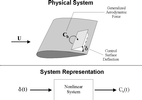 OVERVIEW
OVERVIEW
 DESCRIPTION: Nielsen Engineering & Research (NEAR)'s Kernel Identification System is made of two integrated software modules: a prediction module and an extraction module. The software is based on the Volterra-Wiener theory of nonlinear systems and applies to nonlinear time-invariant systems with finite memory. The theory [1-3] asserts that the response of such systems to arbitrary time-dependent inputs can be constructed by integrating a nonlinear functional which is a fundamental characteristic of the system being modeled. NEAR's Kernel Identification System currently implements a subset of Volterra-Wiener theory, namely the two-term truncation of the Volterra series for a single-input, multiple-output system. The system in question is modeled as a black box, i.e.:
DESCRIPTION: Nielsen Engineering & Research (NEAR)'s Kernel Identification System is made of two integrated software modules: a prediction module and an extraction module. The software is based on the Volterra-Wiener theory of nonlinear systems and applies to nonlinear time-invariant systems with finite memory. The theory [1-3] asserts that the response of such systems to arbitrary time-dependent inputs can be constructed by integrating a nonlinear functional which is a fundamental characteristic of the system being modeled. NEAR's Kernel Identification System currently implements a subset of Volterra-Wiener theory, namely the two-term truncation of the Volterra series for a single-input, multiple-output system. The system in question is modeled as a black box, i.e.:
| X(t) (input) |
-> |
|
-> |
Y(t) (output) |
In prediction mode, the code calculates the first two terms in the series, given the time history of the system's input and the knowledge of its first- and second-order Volterra kernels. In extraction mode, the program extracts first- and second-order Volterra kernels from time domain data.
 INPUTS: In prediction mode, the user supplies the kernels of the system, as well as the schedule of the input X(t). In extraction mode, the user must supply input/output time history pairs. Most inputs are specifiable either in tabular form or in functional (subroutine) form.
INPUTS: In prediction mode, the user supplies the kernels of the system, as well as the schedule of the input X(t). In extraction mode, the user must supply input/output time history pairs. Most inputs are specifiable either in tabular form or in functional (subroutine) form.
 OUTPUTS: In prediction mode, the program computes the system's output Y(t) as a two-term truncation of that system's Volterra series representation. In extraction mode, the program generates estimates of the first- and/or second-order Volterra kernels compatible with the supplied input/output data.
OUTPUTS: In prediction mode, the program computes the system's output Y(t) as a two-term truncation of that system's Volterra series representation. In extraction mode, the program generates estimates of the first- and/or second-order Volterra kernels compatible with the supplied input/output data.

 APPLICATIONS: This software technology can be used to develop reduced-order models of nonlinear systems based on experimental or computational data. For example, the development of such models is critical for efficient integration of fluids, structures and control systems in aeroservoelasticity applications (see Figure).
APPLICATIONS: This software technology can be used to develop reduced-order models of nonlinear systems based on experimental or computational data. For example, the development of such models is critical for efficient integration of fluids, structures and control systems in aeroservoelasticity applications (see Figure).
 AVAILABILITY / PRODUCT INFORMATION: The Kernel Identification System software is available in CDROM format. Licensing the software is subject to an agreement between NEAR (licensor) and the end-user (licensee). The software has been successfully tested on the following operating systems: Linux i386, Solaris 2.5. Disk space needed for installation is less than 10 Mbytes. Prediction module performance: 22ms per output on a 266 MHz PC for a single one-dimensional kernel. The program is available in executable form, plus shared objects in source code form. Shared objects are analogous to dynamically linked libraries; they give the user full control over quadrature and interpolation operations, as well as parameterization and parameter space partitioning. The software distribution includes a 140 page Software User's Manual containing a detailed description of each interface to user-supplied shared objects for increased functionality.
AVAILABILITY / PRODUCT INFORMATION: The Kernel Identification System software is available in CDROM format. Licensing the software is subject to an agreement between NEAR (licensor) and the end-user (licensee). The software has been successfully tested on the following operating systems: Linux i386, Solaris 2.5. Disk space needed for installation is less than 10 Mbytes. Prediction module performance: 22ms per output on a 266 MHz PC for a single one-dimensional kernel. The program is available in executable form, plus shared objects in source code form. Shared objects are analogous to dynamically linked libraries; they give the user full control over quadrature and interpolation operations, as well as parameterization and parameter space partitioning. The software distribution includes a 140 page Software User's Manual containing a detailed description of each interface to user-supplied shared objects for increased functionality.
NOTE: The Kernel Identification System software is a derivative product of NEAR's Indicial Prediction System (IPS). Therefore, many of the code features available in IPS are also part of the Kernel Identification System software. In particular, the software includes IPS's parameterization engine, making the program capable of addressing the characterization of time-varying systems. For more information see NEAR IPS below.
 REFERENCES:
REFERENCES:
[1] Volterra, V., Theory of Functionals and of Integral and Integro-Differential Equations, Dover Publications, Inc., New York, 1959.
[2] Wiener, N. Response of a Non-Linear Device to Noise, Report No. 129, Radiation Laboratory, M.I.T., Cambridge, MA, Apr. 1942.
[3] Schetzen, M., The Volterra and Wiener Theories of Nonlinear Systems, Wiley & Sons, New York, 1980.
Other Mathematical Modeling Tools
Multidimensional Response Surface Package: NEAR RS
Nonlinear Indicial Prediction System: NEAR IPS





